How to Plan a Trip to Guizhou
As a landlocked region in southwest China, Guizhou is an off-the-beaten track travel destination that foreign tourists may have never heard of, let alone make a trip. In fact, Guizhou is even more fabulous than many other parts of China for hiking, photography and adventure lovers.
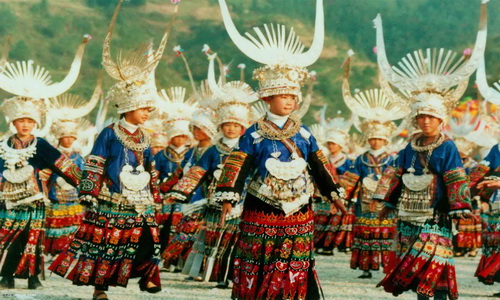
It is home to diverse and unspoiled ethnic minorities, among which the colorful Miao and Dong people still lead their primitive rural life and follow old traditions passed down through generations. What’s more, Guizhou boasts a great number of fantastic natural landscapes including the mighty Huangguoshu Waterfall, fascinating Malinghe Gorge, bizarre Dragon Palace Karst Cave and UNESCO-listed Fanjing Mountain.
Guizhou is blessed with perfect subtropical humid monsoon climate, with an annual average temperature hovering between 10-20 degrees Celsius. Thus Guizhou is suitable for a trip all year round, and you don’t need to be stressed by the summer heat or winter coldness. Breathtaking landscapes and spectacles are offered in different seasons: virescent rural rice terraces of minority’s villages in spring, majestic Huangguoshu Waterfall with biggest torrents in summer, harvest celebrations in cool autumn and colorful festival celebrations in winter.
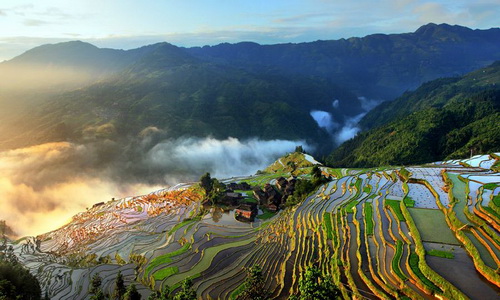
As so many festivals and events varied in villages are observed in Guizhou, you shall take at least one of the festivals into consideration if planning experience their peculiar folk traditions and customs.
Guiyang, the capital city, is nothing special but served as a gateway for traveler to enter the untouched regions of Guizhou. Kaili is a must-go place to explore different tribal villages of Miao minorities, and Zhaoxing is somewhere you could gain impressive insights into untouched Dong Villages and enjoy their great folk song chorus.
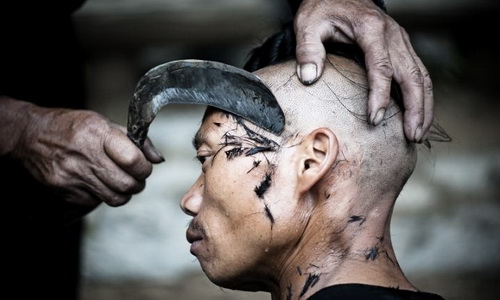
Anshun is not only home to the jaw-dropping Huanggoushu waterfalls and Dragon Palace Karst caves, but also the seat of the untouched ancient military village Tianlong Tunbu. Looking for offbeat places of interests, you shall venture to Congjiang to trace to the last gunman of Basha Miao tribe and absorb the spectacular rice terraces. Or pick up an adventure to Libo to check out of the world’s only karst forest above the water and make a pilgrimage to Fanjing Mountain in Tongren.
Miao Minority – Distinctive Ethnic Culture Varied in Villages
With a population of more than seven millions, Miao is the largest ethnic minority in southwest China. There are a number of Miao villages scattered around Kaili City, and they still maintain traditional lifestyle by living in the wooden stilted houses and wearing ethnic hand-made costumes. Silver ornaments are the most eye-catching charm of Miao minorities. It is common to see young girls dressed in splendid attire, with huge and elaborate silver headdresses, necklaces and bangles for festivals and big events. Actually, on the basis of the same common root, Guizhou Miao minorities has developed many tribal branches with their own distinctive features varied in villages.
- Shiqiao Miao Village: Shiqiao still retains their ancient papermaking technology, and their hand-made paper could be kept in good condition for thousands of years.
- Langde Miao Village: Aka Long-Skirts Miao, Langde is famous for their fabulous costumes of long-dresses and their special way of greeting to guests by offering Block-The-Way wine toasting.
- Basha Miao Village: Basha Miao Village is the settlement for China’s last tribe of gunmen who preserved an isolated and primitive way of life by living in the wooden houses in the forests.
- Paika Miao Village: The village of Paika is famous as a production base for Lusheng, where one could see how sophisticated artists make such a delightful instrument out of reed pipe.
- Qingman Miao Village: As one of the most typical short-skirt Miao villages in Guizhou, Qingman offers a rare chance for one to acquire the complicated hand-making process of their ethnic costumes, including cloth weaving, dyeing, sewing and so on.
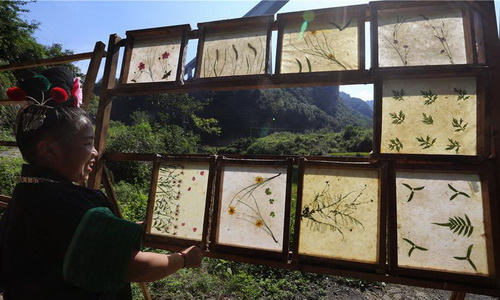
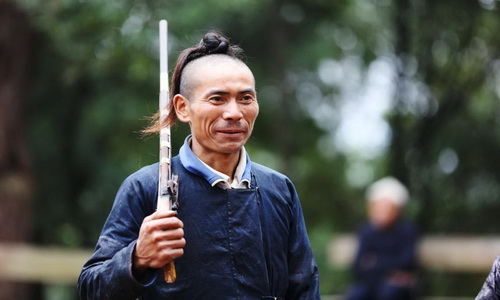
Dong Minority – The Hometown of Kam Grand Choirs
The population of Dong ethnic group amounts up to 2.5 million in China, and Guizhou is one of the main settlement of Dong people. Nearly all Dong villages are nestled on steep slopes and riverbanks, with several storied wooden houses standing on stilts. Each Dong village has their three typical icons, including the Drum Tower, Kam Grand Choir and Wind-rain Bridge.
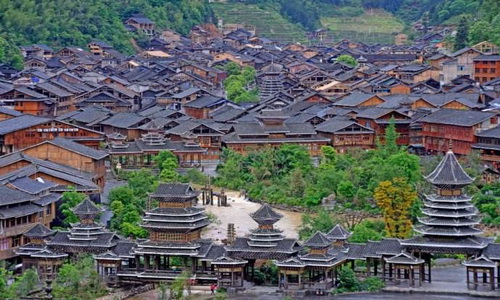
- Zhaoxing Dong Village: It is the biggest Dong Village in China with more than 6,000 tribal dwellers and over 800 households. Quaint wooden-stilt houses are crammed around five iconic drum towers and Wind-Rain Bridges, and the whole village is shaded in serene mountain sceneries.
- Tangan Dong Village: Tangan is one of Guizhou's best kept secrets with a history of 700 years. Secluded in the mountains, the village is a real pastoral world with overlapping rice terraces surrounded by green hills, which is a classic hiking destination from Zhaoxing.
- Huanggang Dong Village: Huanggang is the least known Dong Village hidden in the deep heart of Guizhou. With difficult access from outside world, the village gives a more authentic minority experience by its primitive folk residence and rice fields. It is the true escape for one to get lost in the great nature and untouched humanity.

Endowed with diverse topography, Guizhou Province boasts an array of natural wonders ranging from splendid waterfalls, astonishing gorges, and grotesque mountains to karst forests.
Huangguoshu Waterfall: As the largest waterfall in Asia, Huangguoshu is the number one natural draw of Guizhou. Blessed with a striking width of 83 meters and height of 67 meters, Huangguoshu could be admired from all angles, even via a Water Curtain Cave behind the main waterfall.

Malinghe Grand Canyon: Malinghe gorge is crowned as the most beautiful scar of the globe. Numerous clusters of waterfalls cascade down from the precipitous cliffs, which become superb spectacles for a hiking along the deep gorge all year round.
Wanfenglin: Made up of tens of thousands of pyramidal lush peaks, Wanfenglin is the one of the most marvelous karst landscapes in China southwest. The picturesque villages and eight-diagrams shaped fields inlaid between form breathtaking idyllic sceneries.
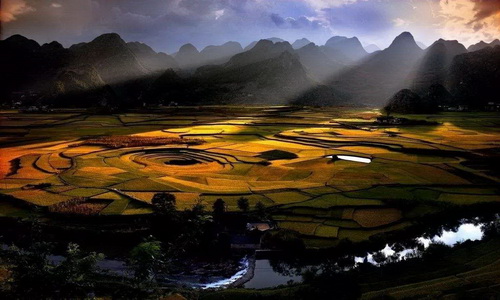
Fanjing Mountain: Mount Fanjing is a renowned Buddhist Mountain with abundant wildlife species like golden monkey and Chinese dove tree. An awesome cable car could take visitors to the holy temples perched on the top of a single abrupt peak up in the cloud, from which you could snap amazing panorama of the valley and hill slopes.
More than 50 ethnic minorities reside in Guizhou. Hundreds of festivals and events take place throughout the year, and even each village has their own special days to celebrate. If you plan to visit Guizhou, you would have a fair chance to hit at least one of the traditional festivals. Here below lists the biggest ethnic festivals worth joining in if your travel time allows. Please note that the festival time is not fixed, but changes every year as most of them are observed on the basis of a Chinese lunar calendar.
Miao’s New Year: Usually falling on Nov., it is the largest festival for Miao minorities to celebrate the rice harvest. Festivities include worshipping ancestors, playing Lusheng and dropping by neighbor villages.
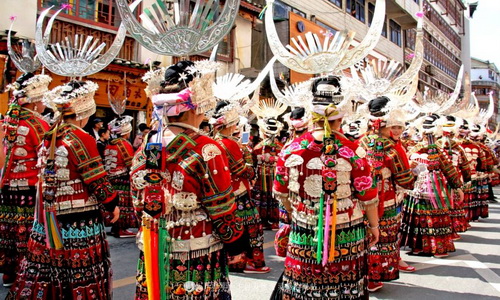
Dong’s New Year: Dong people observe their lunar new year in Jan or Feb by ancestors worshiping rituals, antiphonal singing and Dong Opera.
Lusheng Festival: Lusheng is the most popular musical instrument among Miao and Dong tribes. The festival is celebrated by both of them via delightful antiphonal singing, bullfight and friends’ gathering.
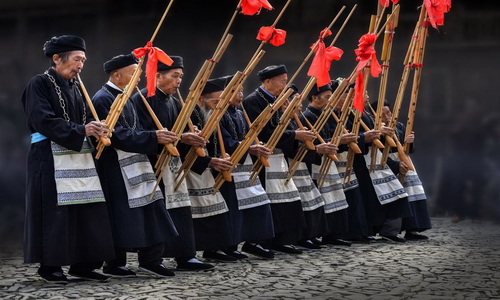
Sister Meal Festival: Also called Oriental Valentine’s Day, it is one of the biggest and most influential event in Guizhou. Young girls dress up to date with their soul mates by dancing to Lusheng and enjoy the five-color sister meals for good luck in love.
March-Third Day: It is the biggest festival of Buyi ethnic group when people gather for singing in antiphonal style and bullfight competition.
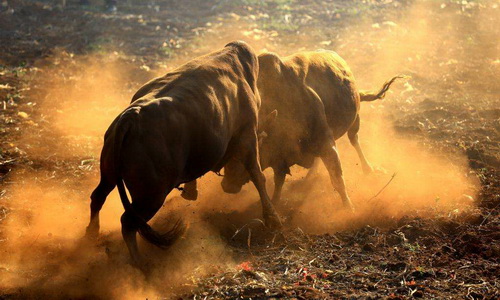
You are suggested to take the Capital City Guiyang as the entry city to Guizhou Province. Direct flights are in service from major travel destinations of China, including Beijing, Shanghai, Xian, Chengdu, Hangzhou, Guilin, Chonqing, Kunming, etc.. Besides, you could use the high-speed trains to reach Guiyang from nearby hub cities, such as Hong Kong, Guilin, Guangzhou, Chengdu, Chongqing and Kunming. The durance of the train ride is no more than 5 hours.
Inside Guizhou, normal trains are running between some hot travel stops such as Kaili, Anshun and Zhenyuan. However, most villages and spots to see are veiled in the mountains that can only be accessed by vehicles. Therefore, the most doable way for you to move around the attraction is to ask for a private car with an experienced insider driver, or join in a privately escorted tour.
See our elaborately designed Guizhou Tours:
6-Day Ethnic Minorities Exploration
4-Day Kaili Minority Miao Villages Discovery
4-Day Huangguoshu Waterfall & Untouched Village Tour









